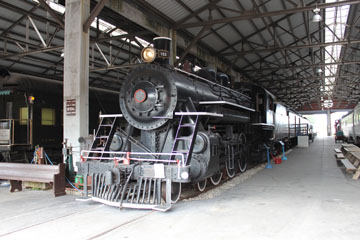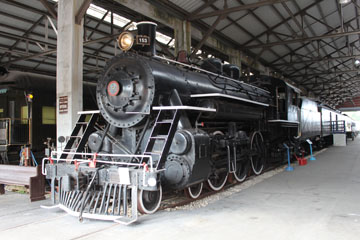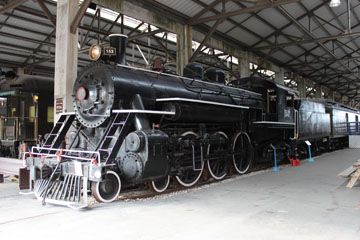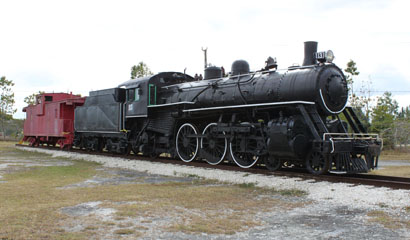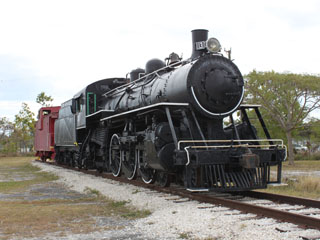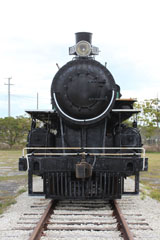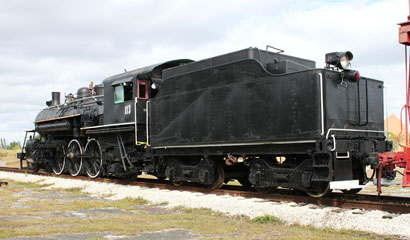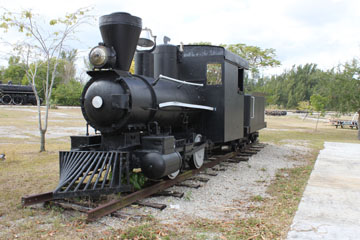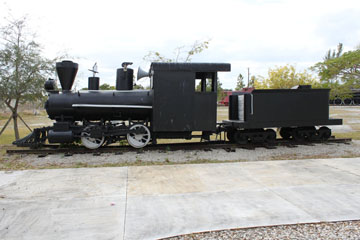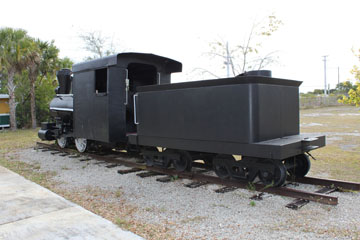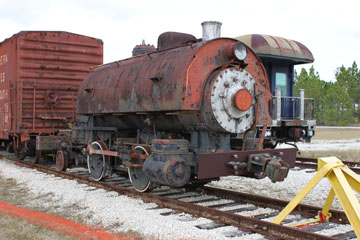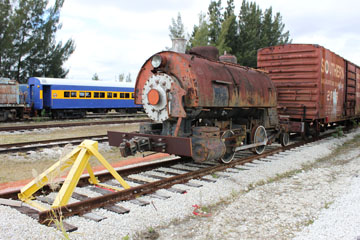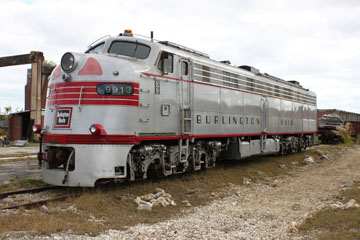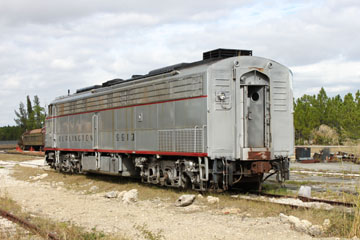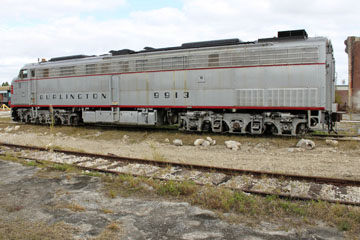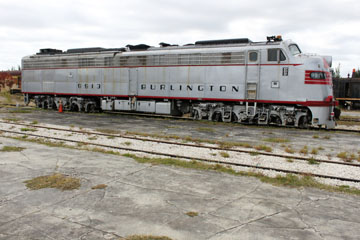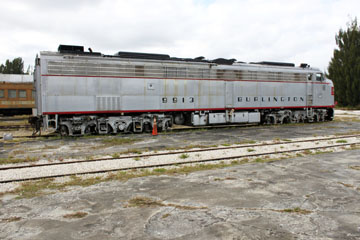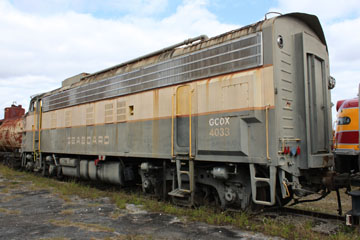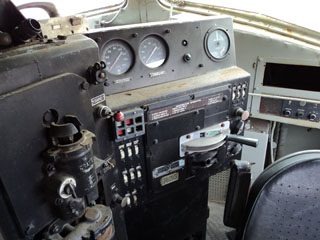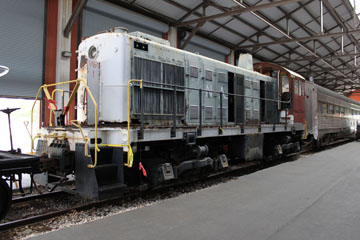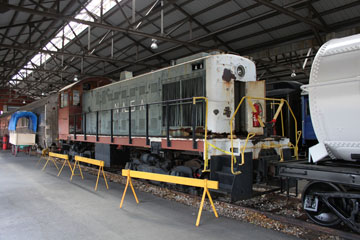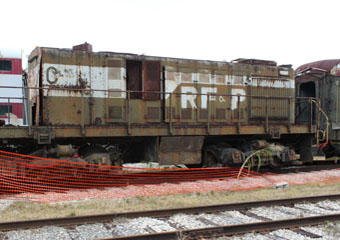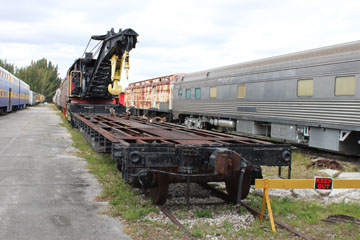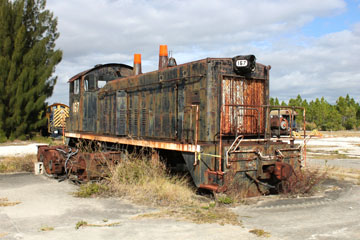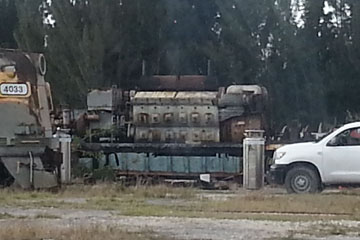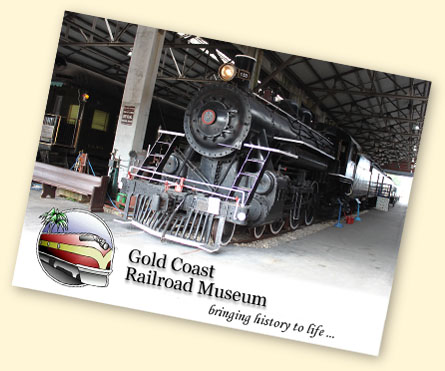

Located right next to the Miami Zoo in Dade County, FL, the Gold Coast Railroad Museum has some interesting pieces in its collection. Several are clearly well looked after, but others seem to have deteriorated quite badly due to lack of attention. However, the majority of these show on the museum's website as "No longer on roster".
The museum had its beginnings in University of Miami student William J. Godfrey's interest in ex-WWII airship Naval Air Station Richmond in Dade County, then leased to the university and containing miles of unused railroad tracks. In 1957, Godfrey arranged for FEC #153 to be donated to the university and the Miami Railroad Historical Society was formed to oversee the maintenance and operation of the locomotive. The collection grew over the ensuing years until, in 1966, it was forced to move to Ft. Lauderdale because of government requirements to use the old Naval Station.
Forced out of its Ft. Lauderdale site by a planned interstate highway, it returned to the Naval Station in 1983 where it has continued to grow to this day.


Florida East Coast Class 151 #153 is an oil burning light Pacific type (4-6-2), one of seven built for the railroad by Alco in 1922 (#151-#157).
They joined eighty Pacifics of similar size bought by the FEC between 1907 and 1922.
The locomotive has 22" x 26" cylinders and 68" drivers. With a 47.10 sq ft grate, 160 sq ft fire box, and total heating surface of 2,554 sq ft (including 442 sq ft superheating), it operated at a boiler pressure of 180 psi and delivered 28,314 lbs tractive effort.
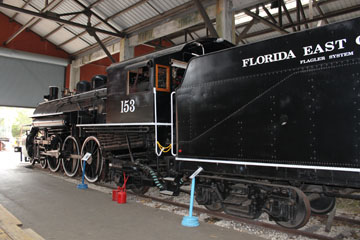

#153 regularly worked the Miami-Key West run until a 1938 hurricane destroyed that road bed.
In 1940, it was sold to the United States Sugar Corporation at Clewiston, FL. In 1957, it was donated to the University of Miami and stored on the Gold Coast Railroad Museum's site at Port Everglades, FL. There, it operated every Sunday from March 1957 until November 1966, when the museum moved to Fort Lauderdale, FL, and it received a $10,000 major overhaul. In 1984, it moved with the collection to the current site and had further restoration work from 2000 to 2002.

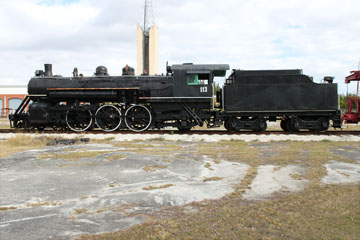
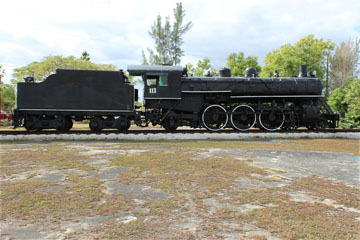
#113 was built by Alco for FEC in 1913, one of sixty Pacifics (#77-#136) delivered between 1910 and 1917. Like #153, it weighs 204,00 lbs, has 68" drivers and 22" x 26" cylinders. #113 was later superheated, and operated at 180 psi delivering 28,314 lbs tractive effort.
#113 was sold to the United States Sugar Corporation at Bryant, FL, in 1938. In 1968, it was donated to the museum at Fort Lauderdale, FL. After moving with the rest of the collection to Miami in 1984, it hauled a one-time special in 1986 from Miami Zoo to Homestead, FL

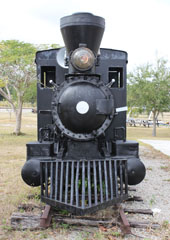
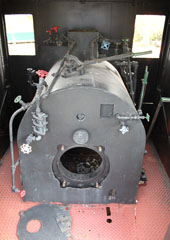

This 36" gauge 0-4-0 was built by Alco in 1922 for the Winston Co., of Edgefield, SC. It may have been built as a tank locomotive and later converted. #48 passed through many owners, including Bona-Allen Inc., of Buford, GA, the Georgia Lumber Co., Lake Lure Scenic Railroad, the Daniel Boone Railroad and James Wells of Fairfax, VA, before arriving at the museum.
#48 is a coal burner weighing 42,000 lbs with 30½" drivers and 11" x 16" cylinders. It operated at boiler pressure of 165 psi, delivering 8,900 lbs tractive effort.

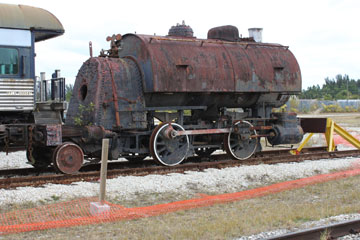

Built by Alco in 1920 for stock, this 0-4-2T (Tank) locomotive was sold to the Coronet Phosphate Co., to work at its Tenaroc mine in Lakeland, FL. At some time, #7 was sold to William Gooch of Polk City, FL, and then donated to the Jacksonville Chapter of the NRHS. In 1982, it was transferred to the Central Florida Chapter of the NHRS who then donated it to the museum.
An oil burner weighing 97,000 lbs with 39" drivers and 14" x 22" cylinders, it operated at 180 psi, delivering 16,500 lbs tractive effort. It has been disposed of since publishing this page,

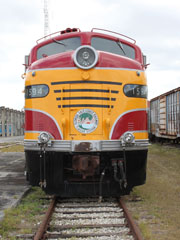
This E8 A unit was originally PRR #5794, but it has been repainted as FEC #1594.
Built in 1952, it was one of forty-six E8 A units delivered to the Pennsy that year, bringing the PRR's final roster to seventy-four of these passenger units bought between 1950 and 1952.
They joined Penn Central in 1968 when #5794 was renumbered #4254. It retained that number under Conrail in 1976 and later under the Massachusetts Bay Transportation
Authority. It was then
sold to a movie prop company in Saugus, CA, known as the Santa Clarita Railway.


At some point, #4254 was leased to Tennessee 200 Inc., a company set up in 1993 to prepare for celebration of Tennessee's 200th anniversary in 1996. Along with ex CB&Q E9A #9988, shown next on this page, it was painted in the old Louisville & Nashville blue and cream livery and lettered Spirit of Tennessee. The units toured with trains of bi-centenary exhibits that year.
#4254 arrived at the museum in 2002. Although recently painted in FEC's historic red, yellow and silver livery used from 1939 to 1962, It is awaiting repairs and is not currently operational.

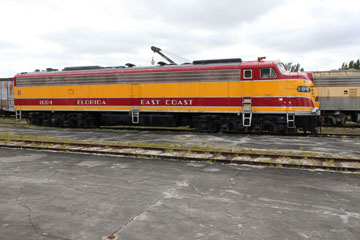
Four hundred and forty-nine bulldog nosed E8 A units were built by EMD from 1949 to 1953: four hundred and forty-six for US railroads and three for Canadian. Two 1,125 hp 567B 12 cylinder prime movers each drove their own GM D27 generator to power the unit's traction motors. Forty-six cabless E8 B units were also built from 1949 to 1954, all for US railroads.
Fifty-eight E8s have survived. You can see SOU #6900 on the North Carolina Transportation Museum page of this website and NYC #4085 on the National NYC Museum page.

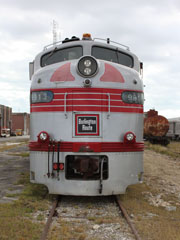
An EMD E9 A, this unit was built in January 1956 for the Chicago Burlington & Quincy as #9988-B.One of ten E9s (#9985-A/B-#9989-A/B) ordered by the CB&Q, it was the last of the railroad's E-units.
EMD built one hundred
of these A units and forty-four cabless B units from 1954 to 1964, all for US railroads. The E9 was the last of EMD's E units, and differed from the earlier E8 by having two newer 1,200 hp 12 cylinder EMD 567C prime movers.
These 316,000 lb units developed continuous tractive effort of 31,000 lbs at 11 mph with a top speed of 85 mph.
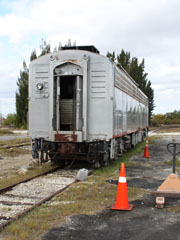
Renumbered #9983
when the Burlington Northern was formed in 1970, this unit was rebuilt in 1973 by Morrison Knudsen, renumbered #9913 and redesignated Class E9AM. It transferred to Chicago's Regional Transportation Authority (later METRA) in 1974 and hauled commuter trains as #9913 until it was retired in 1992.
It was bought by Indiana Transportation Museum in 1994 and then sold to Tennessee 200 Inc., in 1996. Repainted, like FEC #1594 shown earlier on this page, it hauled
the state's bi-centenary exhibits that year, and was finally bought by the museum in 2002.

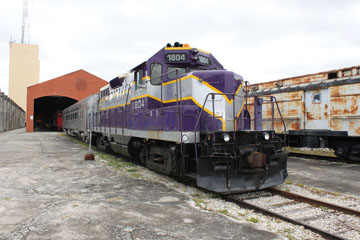
If, as the museum's website says, ACL #1804 is
the "workhorse" of the Gold Coast Railroad Museum, it is typical of EMD's GP7. They proved
so popular with US railroad's that EMD's La Grange, IL, plant could barely keep up with demand, even after the company opened a second assembly plant in Cleveland, OH. Two thousand, six hundred and fifteen of these units were built between 1949 and 1954 for US railroads, one hundred and twelve for Canadian and two for Mexican. In addition, five cabless GP7Bs were built for the AT&SF. They were the first EMD road locomotives to use a hood unit instead of a car body design.
EMD's first attempt at a road-switcher, the car body design BL2, had not been successful: only fifty-eight units were sold from April 1948 to May 1949 (you can see BL2s on the National Railroad Museum page of this website, and the B&O Museum Yard & Car Shop page). The GP7 swapped the BL2's truss-framed stressed car body for an un-stressed body on a flatcar-like frame that EMD's competitors had used from the start. These 56' 2" long, 246,000 lb units had an EMD 567B 16 cylinder engine powering a GM D12 generator to drive four GM D27B traction motors.
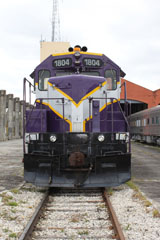
#1804 was one of twenty GP7s built for the US Army Transportation Corps in 1951 (#1821-#1840). It then worked hauling both freight and passenger trains on the Alaska Railroad as #1834 for most of its life, later renumbered #1804.
Like FEC #1594 shown earlier on this page, #1804 was then sold to the Santa Clarita Railway. It was bought by the museum in 2002 and painted in the former Atlantic Coast Line livery. It is regularly used on switching at the museum's yard, and provides cab rides at weekends.

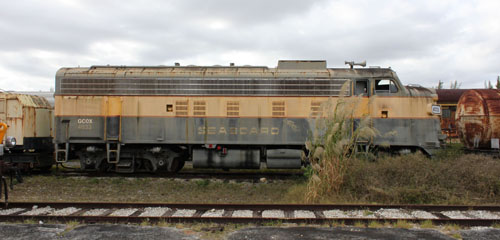
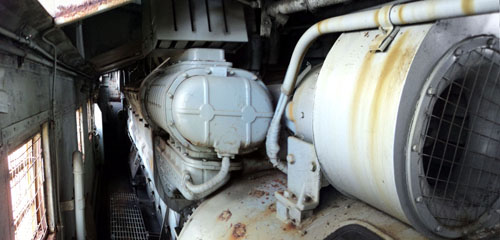
Liveried as SAL #4033, this 1,500 hp unit was built as an F3 for the Gulf, Mobile & Ohio Railroad in 1946 as #800. EMD built one thousand, one hundred and eleven of these A units from 1945 to 1949, as well as six hundred and ninety-six cabless B units (the GM&O rostered thirty-two A units and eight B units).
#800 was later renumbered #800A and was then rebuilt by the Illinois Central Gulf Railroad at its Paducah, KY, shops in the late 1970s as FP10 #1101 for the MBTA. In the early 1990s, it was sold to the Cape Cod Scenic Railroad before being bought by the museum in 2003.
The FP10 designation was given by the ICG to its rebuilt F3 and F7 units, but was never agreed by EMD. The rebuild gave the units full length stainless steel air intake grilles, 480V HEP generators at the rear, dynamic brakes and red marker lights in place of classification lights to operate in push mode.
On the right, some photos inside the unit and cab taken by my brother.


When I visited, #1 was undergoing an overhaul in readiness for the next tourist season: it sometimes provides cab rides at weekends and is also used to switch equipment at the museum.
Built by Alco, the S-2 is a 229,700 lb, 44' 5" long 1,000 hp switcher. It has a 4-cycle Model 539 6L prime mover powering a GE GT553 generator to drive four GE 731 traction motors. One thousand, five hundred and two of the units were built from 1940 to 1950.
#1 was built in 1943 for the US Army. Acquired by the Department of Defense along with two other
S-2s (numbered #2 and #3) to work at NASA's Kennedy Space Center at Cape Canaveral, FL, it was used to move spacecraft components and fuels on Space Center property.
The thirty-eight mile NASA Railroad, built by the Florida East Coast Line in 1963, connected its mainline to the Cape Canaveral Air Force Station. Because of its hazardous operational nature, NASA bought the line in June 1983. That year, NASA also bought three EMD SW-1500 switchers built in 1968 and 1970 from the Toledo, Peoria & Western Railway to replace the aging S-2s, which were then donated to the museum.

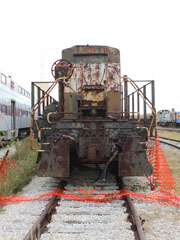
At some time, the Richmond, Fredericksburg & Potomac had three "slugs", or cabless auxiliary units rebuilt from Alco S-2 switchers. They were assigned letters of the alphabet: #A, #B and #C.
#C was rebuilt from RF&P S-2 #71. The railroad rostered twenty-two S-2s purchased between 1942 and 1948. #71 was the last in an order of ten delivered in 1948 (#62-#71).
Although still on the museum's roster, #C is in poor condition. This is a shame as it appears to be the sole surviving RF&P unit still in the railroad's original livery.

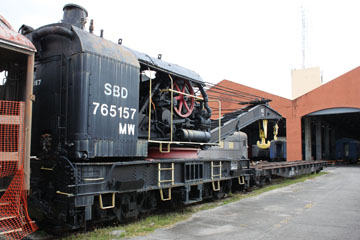

This 150 ton steam operated crane was built in 1919 for the Atlantic Coast Line as #65157 by Industrial Works of Bay City, MI, later the Industrial Brownhoist Corporation. The crane became #765157 with formation of the Seaboard Coast Line in 1967 and retained that number when the Seaboard System was formed in 1983.
You can see other Industrial Brownhoist cranes on the B&O Museum Yard & Car Shop page of this website, the Nevada Northern Railroad Museum page, the Ogden Union Station page and the Pennsylvania Railroad Museum Yard page.

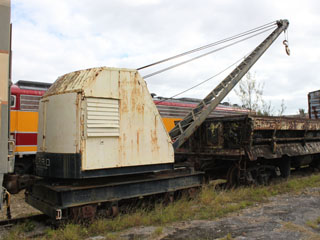
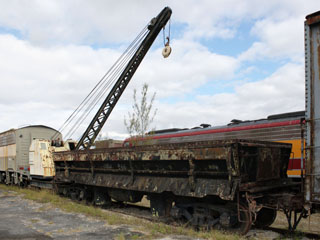
The history of this little Burro Crane built by the Cullen-Friestedt Company of Chicago, IL is unclear. However, small cranes like this were commonly used for maintenance of way work, such as lifting rails and ties, installing signalling equipment or point systems. The boom can be fitted with different tools depending on the assignment, from the simple hook hanging upside down here to an electromagnet.
Burro cranes were named after the favoured pack animal of the old West, a Spanish breed of donkey.


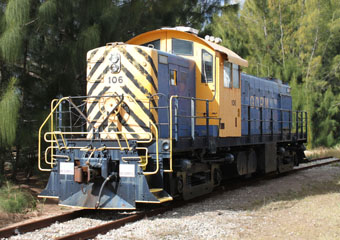
Liveried as Gold Coast Railroad Museum #106, this RS-1 switcher is listed as no longer on the roster on the museum's website, although in quite good condition.
#106 was built by Alco in 1951 for the Savannah River Site, a nuclear facility next to the Savannah River in South Carolina. The site was built during the 1950s to refine materials for nuclear weapons and is owned by the US Department of Energy.
With an Alco 439T prime mover, four hundred and sixty-nine RS-1s were built by Alco-GE between 1941 and 1953, and then by Alco from 1953 to 1960, the longest production run of any diesel locomotive for the North American market.
Several Rs-1s have survived and you can see Duluth, South Shore & Atlantic RS-1 #101 on the Lake Superior Railroad Museum page of this website.

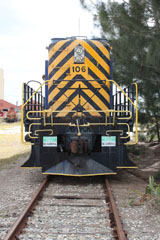


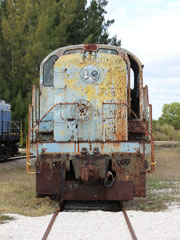
Another locomotive that has been sold since this page was first published, this Alco RS-3 was in quite poor condition when I visited. It was basically a shell, with no traction motors, prime mover or generator.
Internet chatter had been running for years about its future disposition. However, it appears to have been sold to a private collector some time in 2008, and was then sold for scrap parts in 2013.
Seeing motive power in this condition is depressing but, fortunately, there are plenty of surviving
RS-3s in museums and collections around the country.
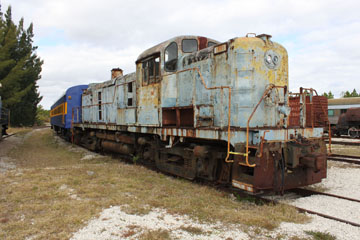

#1555 was one of ten RS-3s delivered to the Long Island Railroad in 1955 (#1551-#1560).
The unit worked at various locations for the railroad into the 1970s, including apparently hauling at least one railfan excursion on Long Island's Bushwick Branch from Fresh Pond, Queens, to Bushwick, Brooklyn, in 1967. It then saw time on several Sloan Cornell owned lines, including the Gettysburg Railroad, Johnsonburg, Kane, Warren & Irvine and the Knox & Kane in northwestern Pennsylvania. It then served on the Maryland Midland before coming to the museum some time in the mid 1980s.


One thousand, two hundred and sixty-five RS-3s were built for U.S. railroads, ten for Mexico, forty-eight for Brazil, six for Cuba and five for Algeria. Ninety-eight were built for Canadian railroads by MLW. Weighing 229,000 lbs and 55' 11" long, they have a 4-cycle Model 244 V12 prime mover, GE 581 generator and four GE 752 traction motors.
You can see NN RS-3 #109 on the Northern Nevada Railroad Museum page of this website, NW RS-3 #300 on the Virginia Museum of Transportation, WM RS-3 #195 on the B&O Museum Yard & Car Shop and RDG RS-3 #467 on the Steamtown Yard page.


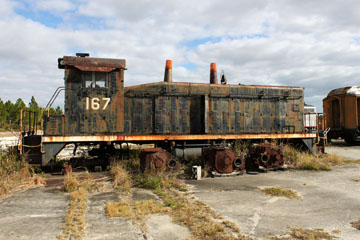
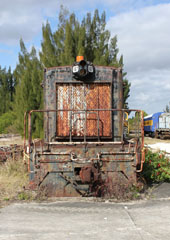
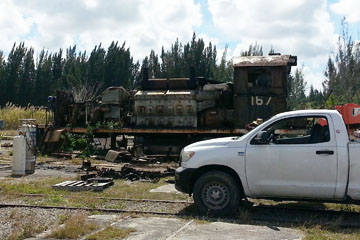
Another locomotive listed as no longer on the museum's roster when I visited (incorrectly as an EMD SW1), EMD SW9 #167 was built for the Atlantic Coast Line as #685 in 1951. It was one of sixty-four delivered to the ACL from February to November that year (#652-#715). One more, #716, was delivered in December 1952.
In 1967, #685 became Seaboard Coast Line #167 following the ACL merger with the Seaboard Air Line, and retained that operating name and number when the larger Seaboard System was formed in 1982.
Unfortunately, only three EMD SW9s have
survived, (you can see another, Seaboard SW9 #2289, on the Virginia Museum of Transportation page of this website), so it was a shame to see #167 like this. Owned by a private individual, it had languished in the museum yard for more than twelve years. Then, over four days from 21st-23rd March 2013, the unit was stripped down in the museum yard. Salvageable parts were apparently re-used.
These two photos are courtesy of Tom Flanery, Treasurer of the Gold Coast Railroad Museum.
Between 1950 and 1953, 808 of these 44' 8" long, 248,000 lb units were built for U.S. railroads and 29 were built by GMD for Canadian railroads. A 567C 12 cylinder prime mover produced 1,200 hp, with a GM D15C generator driving four GM-D37 traction motors, one on each axle. With a top speed of 65 mph, it produced 43,000 continuous tractive effort at 11 mph.
#167 was in a very parlous state, having been jacked off its trucks. Plants grow around the traction motors that lie on the concrete and are creeping up into the gutted body and cab.

A number of photos from this page have been used to illustrate articles on the Gold Coast Railroad Museum website.





